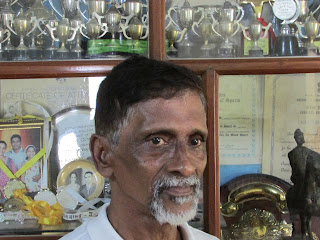There was a time when football in Goa produced some of the
finest defenders in the country. They were mostly tall, hard to get by and
rarely lost an aerial dual. In this era stood out Socorro Coutinho because he
was the shortest of them all. If the others were six feet, Soccoro was just
about four or perhaps even less . Yet , to get past Socorro was more difficult
than getting past any wall.
Soccoro was known as the soft giant from Varca who would never
let the ball past him. If the ball had to go through him, one had to roll past
Socorro and he was one player who could not just be beaten on the ground but on
the air too.
“ When I was young, I used to tie strings against two mango
trees next to my house and practise high jump every day. Whenever I was free, I
used to practise jumping and that is the reason why I used to jump so high to
head the ball,’ explains Socorro.
Like many football players of his time, Socorro started
playing when in school. From school he joined Mocidade de Colva for a year and
switched to Shantilal SC for the next. From Shantilal to Sesa Goa and finally
to Dempo Sports Club in 1969. “ I started with a monthly salary of Rs 75 per
month. I was employed as mechanic,” recollects Socorro.
Socorro Coutinho started playing football by stuffing grass
in his socks. As he grew in love with the game and grew as a player, he
continued by stifling attacks. He
actually started as a midfielder but it was his ability to fall back that saw
him being pushed to the defense by Coach Cyril Feraao.
“ I could burst down chasing for the ball. Seeing this
ability to run after the ball prompted Cyril to ask me to play as defender.
That is how I was moved to the defense with Dempo sports Club,’ avers Socorro
Coutinho.
Despite his height, Socorro had a reach for the ball that
stupefied spectators in Goa . He could leap high to intercept any ball;slide to
tackle any forward from getting past him and had a shot at goal that made him a
master of set pieces for many years with Dempo Sports Club.
Before the arrival of the Brazilians , Dempo SC had a
Mexican coach called Arthur(I forget his surname).Arthur was saw the power in
Socorro’s shot and from then on – as long as he was there- Soccoro was his dead
ball specialist. “ He has a shot that can break a pole,” Arthur once said about
Socorro.
Soccoroo Coutinho represented Goa for fifteen years in the
Santosh trophy. He was called for six India selection trials but never found
himself in the final team. “There was something
to it. It was not that I was not selected because there were better players
then me. It was just that I was not to play for India,” says Socorro.
After joining Dempo in 19169, Socorro continued till 1983.
It was in 1983 after playing with a shoulder holder for almost six months – or
maybe even more- that Socorro stopped playing. “ I had a dislocation during the
match against Punjab police in Calicut. I dislocated my shoulder after falling
wrongly. There were no hospitals close by and no extra players. I was bandaged
and continued playing. I continue playing for over six months with a bandage,” recollects
Socorro.
“In our days we had eighteen players who played eleven
positions. There was hardly any surplus and there was really no need for
surplus because we all played in any position when we had to. It was a type of
total football that each player had inculcated in himself,” reflects Socorro.
“In our days, if we started wall passing on the left it was
a signal that a ball would be floated on the right. We understood each other
well and we had our own styles of messaging each other. That is why our games
were so unpredictable and so exciting,” explains Socorro.
“At our time we played 3-2-5. Yet, we were so compact. It is
different now and it is not a difference that is improving the quality of
football. Football without mental and physical strength is not football. It is another game and that is why people do
not flock to see games these days,” says Socorro.
“Arthur (the Mexican coach) was a tactician. He had immense
knowledge of the game and in my opinion was one of the best Dempo had. Bob Bootland
was a physical fitness buff. Tuesday and Friday were his death days. He brought
the standard of physical fitness to such heights that we were venerated wherever
we went for the manner we could play,” recollects Socorro.
“ In my days , I used to eat a lot of tender coconuts. Maybe
five or six a day after practise. I think that was the secret of my vitality. I
pushed myself to great lengths and never felt being weighed down. The zeal to do better was always present,”
says Socorro.




